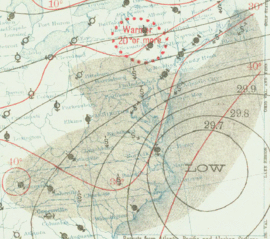Knickerbocker Storm
| Category 4 "Crippling" (RSI: 14.97) | |

Weather map for the morning of January 28, 1922
|
|
| Type |
Extratropical cyclone Blizzard |
|---|---|
| Formed | January 27, 1922 |
| Dissipated | January 29, 1922 |
| Casualties | 98 fatalities, 133 injured |
| Areas affected | Mid-Atlantic states of the United States |
The Knickerbocker storm was a blizzard that occurred on January 27–28, 1922 in the upper South and middle Atlantic United States. The storm took its name from the resulting collapse of the Knickerbocker Theatre in Washington, D.C. shortly after 9 p.m. on January 28 which killed 98 people and injured 133.
An Arctic airmass was in place across the northeast United States; Washington, D.C. had been below freezing since the afternoon of January 23. The front that spawned the cyclone was almost completely dry until after it crossed the Gulf of Mexico, making this storm unique among large southeast snowstorms. Despite the slow start, a low formed and deepened rapidly off the Georgia coast as the cold front reached the Gulf Stream on January 27. Heavy snow quickly developed from the Carolinas to Pennsylvania as the low drifted north to the outer Banks of North Carolina on the 28th. A strong high pressure to the north helped to cut the system off from the jet stream. As a result, the cyclone took three days to move up the Eastern Seaboard, which was double the normal time used by forecasters of that era to move storm systems up the coast. Snow reached Philadelphia and Washington, D.C. by noon on January 28, and continued into the morning of January 29. Temperatures remained in the 20s Fahrenheit (-5 °C) through much of the event.
An estimated 22,400 square miles (58,000 km²) of the northeast United States were affected by 20 inches (51 cm) of snow from this cyclone, which was over one-fifth of the total area that received over 4 in (10 cm) of snow. Snowfall was quite heavy in Maryland and Virginia.Richmond, Virginia recorded 19 inches (48 cm). Baltimore, Maryland was paralyzed as it received the most snowfall within 24 hours since 1872. Parts of North Carolina also received over one foot of snow.
...
Wikipedia
